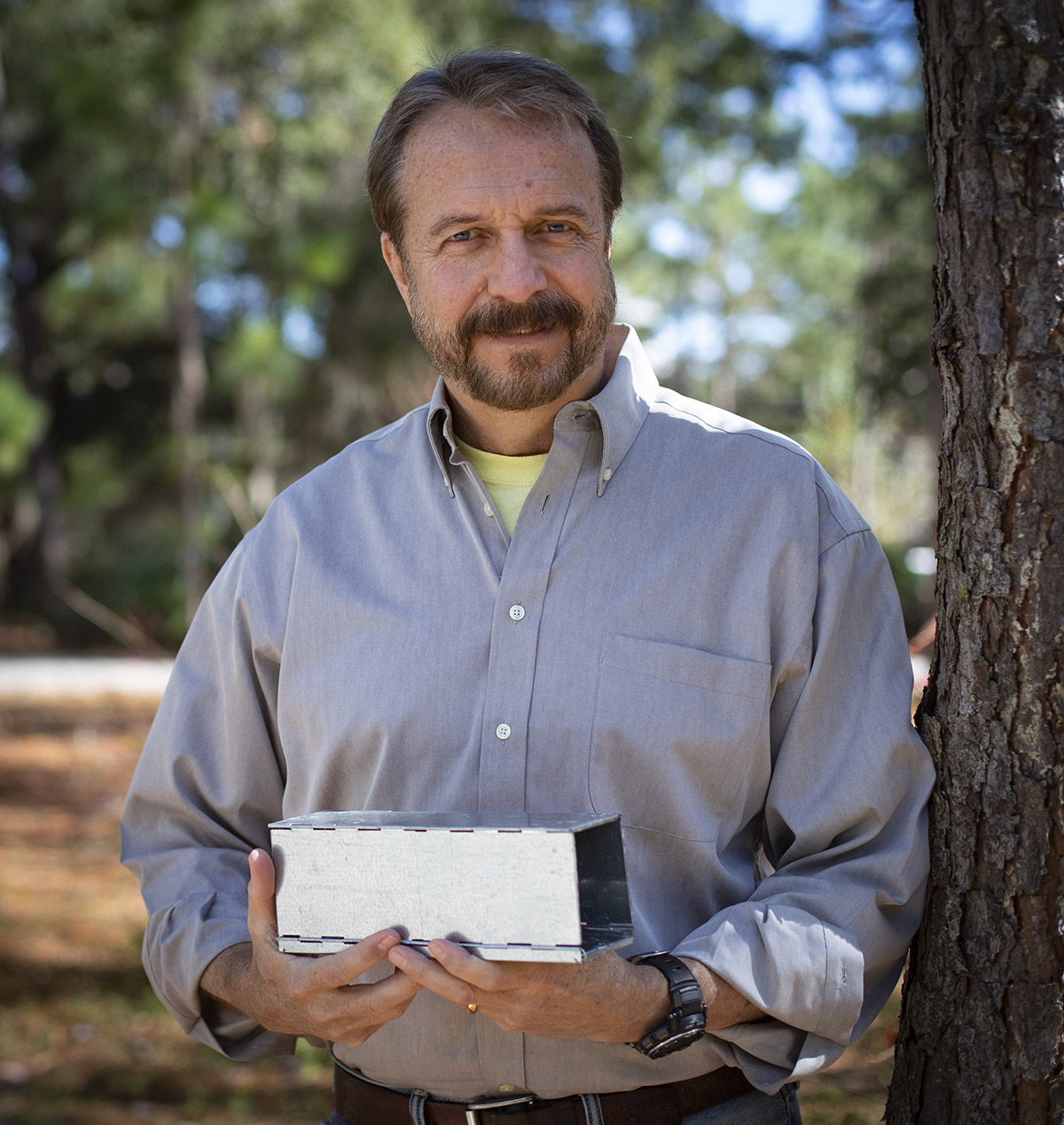December 13, 2018
18-248
VSU Professor’s Wildlife Study Reveals Potential Impact on Disease Transmission in East Africa

|
| Dr. Bradley Bergstrom holding one of the metal traps he used in his research on the plains of Africa. |
VALDOSTA — Dr. Bradley Bergstrom, professor of biology at Valdosta State University, has unearthed new information on East African wildlife in a new study published in the Nov. 27 online issue of the scientific journal “Ecosphere.”
The research, co-authored by Bergstrom and three fellow ecologists throughout the United States, explores the relationship between the vast herds of large herbivores that graze the African grasslands — from gazelles and zebras to giraffes and elephants — and the smaller, less conspicuous nocturnal rodents — such as rats and mice — and what that relationship could mean for humans.
“There’s such a huge range of mammals that live in the savannas of East Africa,” said Bergstrom. “Everybody knows about the large mammals, the elephants, giraffes, zebras, antelopes, and so on. But until now, there’s been practically no work done on the small mammals in this same system. They’re mostly ignored, but for science, it’s instructive to know why certain parts of the ecosystem are kept in check by others.”
While it is widely known that larger plant-eating animals in East Africa suppress the smaller, disease-transmitting rodent populations, little was understood on how exactly that happened.
Ecologists also previously believed that prescribed fires across the savanna would provide more nutrients for the rodents and cause their numbers to surge.
Bergstrom, after months spent on the plains of Africa and years spent doing analysis and lab work, found the opposite to be true, upending popular belief on the topic. The fires reduced the shrubs and grasses rodents use for cover, leaving them exposed to predators such as hawks and small carnivores, his research found.
The fires did enrich the soil, but the increased nutrients attracted the larger animals, whose grazing destroyed any new cover and made the burn areas unfriendly to rodents. In areas left untouched by fires — and especially those put out of reach of larger animals by electric fencing — the rodent populations exploded because of the abundance of cover.
Beyond filling in important knowledge gaps in ecological science, Bergstrom’s research carries significant implications for the health of East Africans. Rodents in the area, when left unchecked, can easily spread potentially deadly diseases to humans, including the plague. As poaching and agricultural development rapidly encroach upon and reduce the large animal populations, the likelihood of surges in rodent populations rises, Bergstrom said.
“More and more, the large herds of native wildlife are disappearing from the savanna landscape, or the land is converted to agriculture,” Bergstrom said. “Without the large grazers to keep rodents in check, their populations can increase 20-50 times or more, posing a big health risk to humans.”
Bergstrom completed the actual field work for the study a decade ago at the 48,000-acre Mpala Research Center in Kenya. While there, he spent more than 1,000 hours trapping rodents using rectangular metal boxes and then tagging and tracking them. Much of his work was done in large experimental plots, including vast swaths of land enclosed by electric fences to keep large animals out in order to see how that exclusion affected rodents.
“I’ve been doing this for 40 years, but I never before had problems with baboons and elephants and hyenas damaging the traps,” he said. “The baboons would fling them as far as they could just for fun, the hyenas would turn the metal into confetti with their teeth, and elephants would accidentally step on and squash them.
“It was exciting, partly because there was always a hint of danger on the horizon. As a researcher you’re not allowed to be out on the property without your native field assistant. These guys herd their cattle through the habitat with nothing but a spear, so they have this almost sixth sense of where the danger is.
“My field assistant was always on the lookout for primarily elephants and buffaloes because those are the two species that injure and kill more people than any others.”
Dr. Truman P. Young, a professor at University of California, Davis and one of Bergstrom’s co-authors, called Bergstrom’s research a “tour-de-force summary of rodent ecology in an important savanna ecosystem.”
“By masterfully integrating rodent trapping data from a wide variety of sites, landscape features, and controlled experiments, he not only provides a baseline of rodent ecology thought the region, but also demonstrates that the key unifying mechanism of rodent abundance is total herbaceous cover,” Young said of Bergstrom. “I know of no similar study in any system with the breadth and depth of detail, which provides a uniquely powerful result.”
Bergstrom’s in-depth study, titled "Searching for cover: Soil enrichment and herbivore exclusion, not fire, enhance African savanna small-mammal abundance,” was funded by both VSU and the National Science Foundation.
On the Web:https://esajournals.onlinelibrary.wiley.com/doi/10.1002/ecs2.2519
Newsroom
- Office of Communications Powell Hall West, Suite 1120
-
Mailing Address
1500 N. Patterson St.
Valdosta, GA 31698 - General VSU Information
- Phone: 229.333.5800
- Office of Communications
- Phone: 229.333.2163
- Phone: 229.333.5983